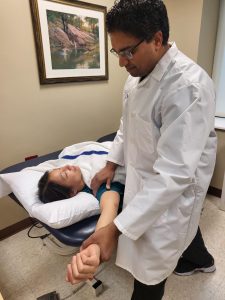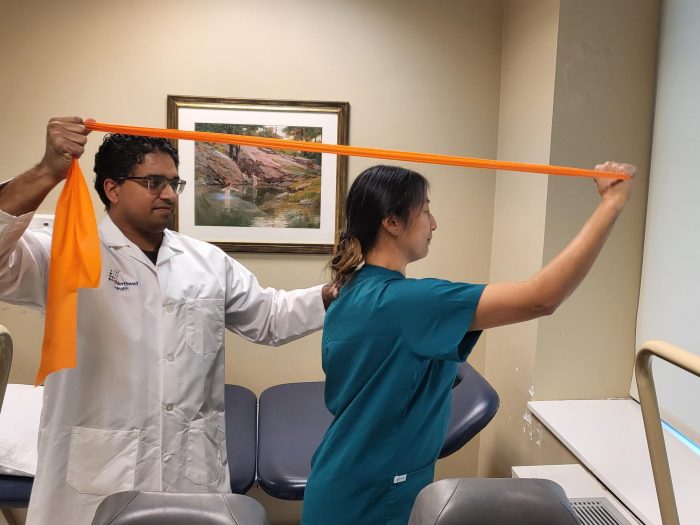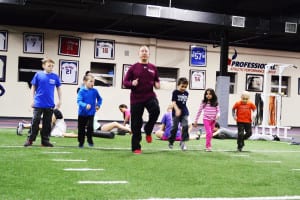Play ball, carefully.

That’s the advice of area physical therapists and orthopedic surgeons as Major League Baseball returns with a shortened spring training.
Some of the less experienced players, particularly those who might feel they need to prove something each time they step on the field, are especially vulnerable to injuring themselves, suggested Dr. James Penna, orthopedic surgeon and chief of Sports Medicine at Stony Brook Medicine.
“You’ll see the experienced players won’t go through it [but] the injury rate among the [players that have been in the league] for five years and under will be higher,” Penna said.
The challenge for players, even at the professional level, is that their training strengthens their body and increases their speed, but it doesn’t help with the kind of urgency a game situation creates for athletes.
“They’re not doing stuff that’s high stakes,” Penna added. “That’s the real difference.”
Staying busy in leagues where no one is watching and then returning to the bright lights of Yankee Stadium or a nationally televised game can cause stress hormones like cortisol to increase.
“It takes three to six years [as a professional athlete] depending on the sport, where you start to get into a routine where it’s not all energy and angst,” Penna said. The athletes who do the same thing all the time won’t have any change in their bodies or their minds when they return to major league games.
Pitchers are among the most vulnerable baseball athletes, as they may try to stretch themselves out with too many pitches and too many innings quickly, said Joel Marimuthu, supervisor of rehabilitation services at Huntington Hospital.
Looking back at 2020, when spring training was also shortened amid the COVID-19 pandemic, the number of injuries increased, Marimuthu said.
“If the players are watching what happened in 2020, especially with all the increased elbow, shoulder, back, hamstring pulls, they’ll be mindful this season,” Marimuthu said.
Complete preparation for game situations includes a range of training and body conditioning and a gradual increase from working in a gym or on a field somewhere to playing in a game.
“You never want to go from 0 to 60 as an athlete,” said Marimuthu. “You want to come up to speed gradually.”
Training a range of muscles involved in different activities can improve strength and flexibility and reduce the risk of injuries, doctors said.
“We see the most benefit from athletes staying balanced,” Penna said. “If you work on a flexion activity, you have to work on an extension activity. As much as it’s become cliche, you have to cross train.”
Even if athletes don’t participate in different sports, they need to engage in activities such as yoga, pilates and lower body work to prevent injuries, Penna said.
Athletes at any level, who think they might have sustained an injury, run the risk of more significant damage if they play through discomfort that goes beyond the usual wear and tear from sports.
Physical therapists use the acronym PRICE as a guide: protect, rest and ice, Marimuthu said.
College sports injuries
The pandemic has created a similar situation for college athletes, who weren’t able to compete for varying lengths of time amid canceled and shortened seasons.
With fewer games and matches, numerous athletes got injured as they returned to
game action.
“We saw a very, very rapid uptick in injuries,” Penna said.
Athletes had higher injury rates in upper body, lower body and core muscles.
Sports hernias were also prevalent, as student athletes didn’t do enough dynamic exercises to strengthen their core and increase their flexibility.
For female athletes, the injuries to their lower extremities are “through the roof,” Penna said, including to the anterior cruciate ligament in the knee. “The ACL [injury] rates among girls is bad.”
Penna urges athletes not to wear cleats on turf. Even though a sneaker might slip, and athletes might not be able to run as fast, they won’t likely have the kind of tearing that comes from a shoe that’s gripping the ground while the rest of the leg moves in another direction.
Coaches and trainers should “go to great lengths to make sure their quads are balanced with their hamstrings and their core is well maintained,” Penna said.
Young athletes in general ignore their core, which means more than just sit ups. Penna suggested they do more dynamic motions, like lunges.
Penna said it’s natural amid stronger competition for athletes of any level to push themselves to levels that might cause injury.
With so many experts available to help with sports injuries, injured athletes of any age and ability, from weekend warriors to high school and college athletes, have numerous places they can go for advice and care after an injury.
Marimuthu and Penna both suggested that the first point of contact should be a primary care physician.
“I’ve always felt comfortable keeping strong primary care doctors around to keep us honest,” Penna said.









